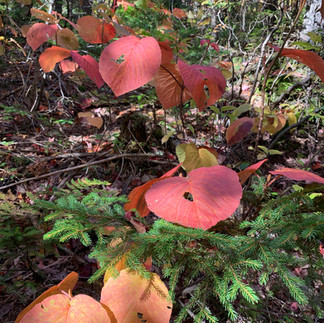A memorable Viburnum – hobblebush
- Rodney Eason

- Jun 5, 2023
- 2 min read
Updated: Jun 20, 2023
Rodney Eason, CEO
My first memory of seeing hobblebush was in 1999 while on a camping trip in Baxter State Park, Maine. Our group was there to climb Katahdin and we arrived a day early to get settled. The night before our ascent, several of us went for an easy hike around a nearby lake.
Walking along a series of wooden boardwalks, I was suddenly struck by a gorgeous, waist-high plant that was new to me. Asking friends from Maine about these plants, they informed me that they were hobblebush or Viburnum lantanoides.
Clockwise from the top left: In flower at Asticou Azalea Garden; in fruit at Baxter State Park; in full color at Baxter State Park; Viburnum lantanoides seedlings; in various shades of fall color; in more fall color.
We were living in North Carolina at that time and once we returned from our Maine vacation, I searched for the plant in Michael Dirr's Manual of Woody Landscape Plants. In Dirr's Manual, I learned that hobblebush grows along the Appalachian Mountains, north into Canada. Being cold-hardy from USDA zones 3 to 5, I gave up hope that it would grow in zone 7b Raleigh, NC.
Years later, when we moved to Maine in 2012, I was delighted to see V. lantanoides growing again. After a bit of inquiry, it appeared that outside of its native range, hobblebush is not easy to grow in a cultivated garden.
Fast forward to this spring when I was walking through our McAlpin greenhouses, chatting with our team. Our volunteer, Helen Koch, was potting up seedlings when I asked which plant she was working with. To my surprise, they were Viburnum lantanoides seedlings.
I posted a photo of these seedlings to my Instagram account and several friends commented about how difficult they had found hobblebush to grow under cultivation. The Preserve is lucky to have both the growing facilities and a wonderful team who can cultivate these remarkable native plants.
Beyond the bold foliage, hobblebush has large white flowers in spring and bright red fruits in the fall which are quickly gobbled up by wildlife. The fall color is splendid. I have hiked in Baxter State Park in early fall and the leaf colors range from light orange to dark maroon.
At the Preserve, you can find Viburnum latanoides growing at Asticou Azalea Garden. You can also find it growing in the wild along Harbor Brook and Jordan Stream.















Comments